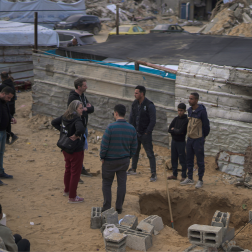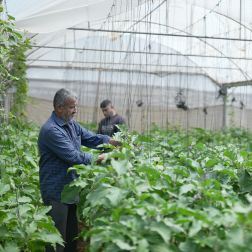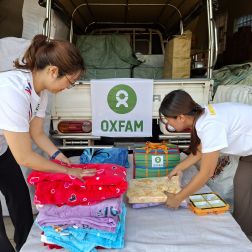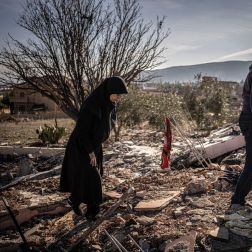- 6 mins read time
- Published: 28th May 2018
A sea of change in the Philippines: local groups take charge in emergencies
Creating a more just and effective system of humanitarian response means helping local and national organizations step to the forefront.
When armed fighters laid siege to the city of Marawi, the Philippines, in 2017, hundreds of thousands of civilians fled for their lives. Many abandoned everything they owned, and in the clashes that followed, their neighborhoods were reduced to rubble and dust.
It’s been many months since the exodus, but for people displaced by the fighting, the pain is fresh. When a visitor toured the camps near Marawi, they told stories of their flight and of the precious things they left behind.
“All my memories were left there,” said a young mother who recently delivered a baby in a tent camp. She cried as she talked about leaving home. “My parents were buried there.”
Yet, even as they rushed to safety, some took on a dangerous, life-saving task. “Many Muslims worked hard to protect their Christian friends and neighbors. They gave them places to hide and helped them get through checkpoints so they could escape the city,” said another mother. “For us,” she added, “it’s all the same if people are Muslim or Christian.”
Giving a boost to local groups
In a crisis, the urge to help your neighbor and your community is a powerful one, which is one reason local aid agencies can be so effective in emergencies. Not only are they often deeply committed to the communities they serve—their proximity enables them to act fast, and their understanding of the context can facilitate aid delivery in countless ways. But NGOs (nongovernmental organizations) in poor countries struggle for resources, and the grants they receive from international sources often consign them to bit parts in emergencies, with little role in shaping the work they’re paid to carry out.
That’s wrong in every way, and Oxfam is trying to address the problem. We are helping lead a worldwide initiative to shift power, skills, and funds from international to strong local and national actors, and the Philippines has been a particular focus.
In 2015, Oxfam began working with Christian Aid and Tearfund on a three-year pilot project known as Financial Enablers, or FEP, to help Filipino organizations (organized into seven consortia) boost their capacity for humanitarian response and preparedness. The goal was more far-reaching than simply to build on skills: it was to strengthen leadership, so participants were encouraged to take charge from the start. Each consortium took on the responsibility of devising its own capacity-strengthening plan, for example, and the FEP followed its lead, issuing grants to make that plan a reality. Less experienced consortia used the money for basic trainings in emergency response, while a more seasoned group known as the Humanitarian Response Consortium (HRC) used it to create a quick-response fund, and to stock three warehouses with equipment and supplies.

A legal aid clinic near Marawi. “People who have lost everything have also lost their legal identities… They can’t access benefits they need, and they can be targeted with harassment and even violence.”-- Norman Golong of IDEALS, HRC’s legal aid organization and an Oxfam partner. Photo: Elizabeth Stevens/Oxfam
An important milestone
As Oxfam readied its response to the Marawi crisis, the HRC announced it was launching a needs assessment—the critical first step in humanitarian response—and asked if Oxfam would like to support its intervention. In the effort to strengthen local leadership, it was a milestone: rather than Oxfam asking local groups to participate in our response, a highly capable local organization was taking the lead and inviting Oxfam to join in.
“In the space of six months, HRC twice led the way on emergency response,” said Rhoda Avila, Oxfam’s humanitarian manager in the Philippines. “This represents a significant transition, and we are really pleased.”
With help from its quick-response fund, HRC immediately canvassed the displaced families and learned about their most pressing needs. Once the team had solid information, it was able to cast a wider net for resources, and before long they had distributed essentials like plywood for tent flooring, hygiene kits, and kitchen utensils; set up communal kitchens and water and sanitation facilities; and begun handling sewage sludge disposal. HRC includes a legal aid organization, which hosted a radio show during the emergency to educate people about their rights, and offered clinics to help displaced people secure identification papers.
“HRC was a great help,” said Noraisah Arumpac, a mother who now lives in a tent camp. “They went from tent to tent to talk to us. They gave us everything we needed and made our lives easier.”
The consortium was not only able to move fast and create a comprehensive response; thanks to local staffers, its work built on knowledge of the local culture.
“I’m from Mindanao, so I understand some of the traditions and culture of the communities we’re serving, and I share their religion,” said Zahara Ibrahim, a hygiene promoter for HRC in the camps outside Marawi. “I find that people are more interested in talking about hygiene if I introduce it by reading verses from the Koran about cleanliness.”
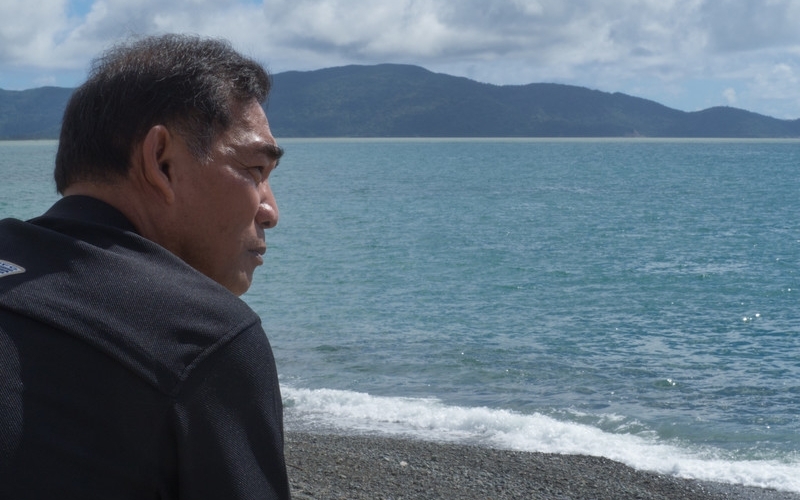
Ivanhoe Arcilla, emergencies official in the town of Virac, Catanduanes, worked with HRC on the response to a deadly typhoon in 2016. “When HRC came, it was so timely. They showed up right after the typhoon. They called me and the next day they were here, and they immediately began an assessment and distributions.” Photo: Elizabeth Stevens/Oxfam
“The vision of the FEP is of strong, confident local organizations that work together to carry out effective disaster preparedness and response,” said project manager Jane Bañez-Ockelford, reflecting on the project before it drew to a close at the end of March.
Clearly, the vision has taken hold, and we’re hopeful that the knowledge and networks the FEP helped generate will continue to deepen and grow.
“The traditional way of implementing disaster response in the past has been that people from the outside controlled decisions and controlled the resources. Local communities affected by disasters were involved only marginally in decision-making,” said Milton Amayun, who works with the FEP-supported CHIC consortium (Capacity-building for Humanitarian Initiatives in Capiz). “What the FEP has done is shift decision-making to the local organizations they supported and the leadership of the communities. The results so far have been timely, culturally appropriate responses at very little cost.”
“When it comes to humanitarian response,” he added with a smile, “local leaders can do the job.”
By Elizabeth Stevens
